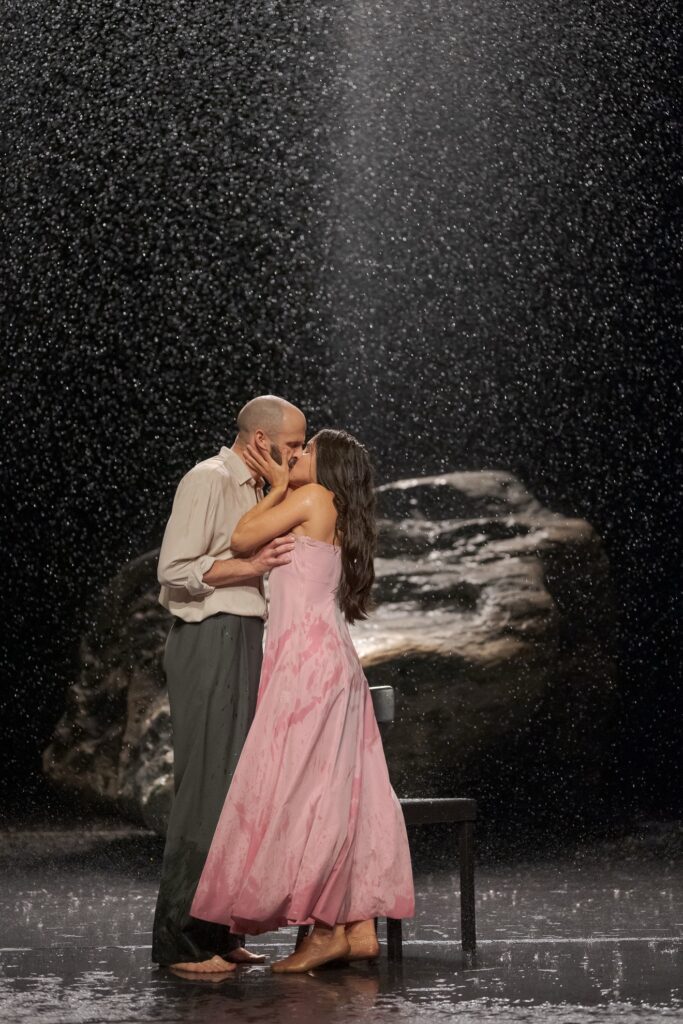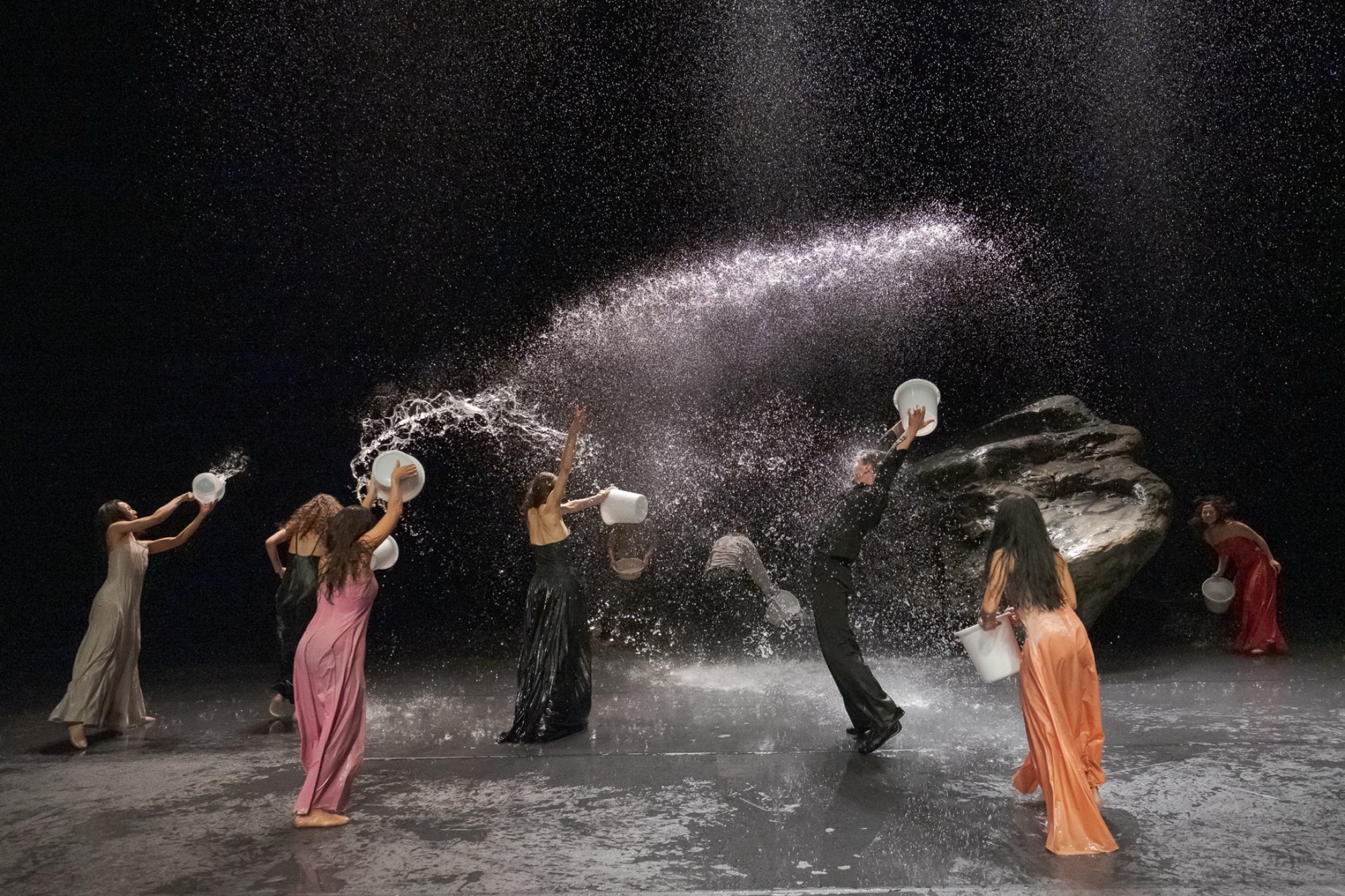Words by Bengi-Sue Sirin.
By pure luck of timing, two Pina Bausch events hit London within one week. Just one is a privilege, so two felt like a gift. As a die-hard Tanztheater Wuppertal fan, of course I went along to both. A week with Pina – what more could one want!
Un jour Pina a demandé…
Firstly, to the BFI as part of the Chantal Akerman retrospective. Akerman, a Belgian film-maker whose 1976 classic Jeanne Dielman is considered by the BFI to be the best film of all time, made this 57 minute documentary following Bausch and company for five weeks. Un jour Pina a demandé captures the dancers in all the moments building up to the show; in rehearsal, in the dressing room, even being interviewed about the Tanztheater’s process.
Akerman’s documentary was released in 1983, at which point many iconic Bausch works had already been created. We see snippets of Komm Tanz Mit Mir (Come Dance with Me, 1977), Walzer (1982) and the much beloved Nelken (Carnations, 1982), which toured to Sadler’s Wells just last February.
The footage is like gold dust; several of Bausch’s early dancers stayed with the Tanztheater for many years and it is amazing to see them in their 20s, kitted out in 1980s dancewear and with more than one mullet. It is well-known that to Bausch, dancers were not just beautiful movers. She chose them for their personalities, their acting skills, and also for what stands out most prominently for me, their humour. I laughed a lot at a scene where the multicultural Tanztheater dancers approached the camera one-by-one, and listed three notable things about their country. For example, a Spanish dancer shouts, “¡Flamenco! ¡Toreros! ¡Picasso!” It is playful, ironically braggadocious and hilarious!
Un jour Pina a demandé feels very true to Pina Bausch’s mentality as it has many moments of humour, but also many moments of profundity. The choreographer was known for starting a new piece as a complete blank canvas, and following the direction of her dancers’ responses to prompts such as questions, invitations to describe memories. In fact, one of the most memorable moments in Nelken was conceived this way. A very young and blonde Hans Beenhakker tells us how when Bausch asked, “What is something you’re proud of?”, he shared that he’d recently spent a summer in America and learned Gershwin’s The Man I Love in American Sign Language (ASL). It is so charming; he is contagiously enthusiastic and signs us the whole song. Thanks to Akerman we see Beenhakker through Bausch’s eyes, and it is not hard to understand why she chose to make this ASL motif so central to Nelken. I felt like I was watching a seminal moment of dance history!
And what of Pina herself? She appears every now and then, at the end of reams of blue spirals of cigarette smoke, nodding her head in rhythmic approval. It is kind of what I already feel about Bausch; her work says it all for her. I’m sure many Bausch fans are familiar with the terrific Wim Wenders film Pina (2011), which in its scale, ambition and vast amount of footage is a fitting ode to one of the greatest artists of all time. If Wenders’ Pina is the grand sweeping elegy read at the funeral, Un jour Pina a demandé is the private shoebox of old letters and photographs kept from the start of the relationship, to savour the person beneath and before the legacy. And is that not at the very heart of any Bausch piece?
Vollmond
A week later, I make my way to Sadler’s Wells for the annual February Tanztheater Wuppertal show. As always, it’s packed. The offering this year is Vollmond (Full Moon), premiered in 2006 and last performed in London in 2013. It was one of the last pieces Bausch choreographed before her death in 2009, which to me bestows some sort of mythical status upon an already visually mythical piece. If you’ve seen Wenders’ Pina, it’s The One With the Rock and the Rain.

For those unfamiliar with Bausch, Vollmond is a perfect example of what she’s about. The company name, Tanztheater, literally means ‘dance theatre’ in German. With origins in Rudolf Laban’s theories of dance, it is a combination of many things: dance, music, speech, sets and the everyday. Bausch is considered to be at the forefront of the tanztheater movement and in my view, Vollmond is tanztheater at its finest. It is a two-act show, with the interval serving as a dividing line. The first half presents each of the tanztheater elements as distinct things – we see the quiet imposingness of the rock glisten in the lashing rain; we listen to humorous interactions between dancers (including a bra-unfastening admonishment) and a range of striking songs; and we see a vast spectrum of movement types, from pouring water into glasses, to beautiful dance solos. Then in the second half, Vollmond throws these elements into a melting pot, blurring the lines between them and showing the narrative power tanztheater can have. I noted that while the first half felt humanistic, the second was animalistic, much more primal. Much like the storied effect of the full moon.
On this note, I couldn’t stop noticing other connections to folklore and all things primeval. The set itself, that giant and unexplained stationary rock, reminds me of Stonehenge, of the monolith in 2001: A Space Odyssey… And by the end of the piece, I’m convinced it has had a similar awakening/corrupting (however you choose to interpret it) effect on the Tanztheater dancers as to Kubrick’s apes. As I mentioned before, the second act transforms into an entirely different beast, ritualistic and lawless like a witches’ Sabbath.
One group moment towards the end sees the dancers imitating waves, their arms curving in scythe-like crescent shapes against the pouring rain. Where the first half shows everyday interactions with water, such as pouring and splashing, the second interacts with it in much more bestial ways. We see running and sliding; dancing free of all inhibitions; throwing the water right back up at the sky almost as though giving thanks for its bestowal. The increasingly frenetic music and movements are in synergy with one another, and everything reaches the point it was striving for, coming full circle like the full moon.
Speaking of full circle, I have to mention one dancer in particular. The marvellous Ditta Miranda Jasifi, a longtime Bausch collaborator whose tiny frame packs immense power and steals every scene she is in. Jasifi is my abiding memory from the Wenders film, and the Vollmond clips especially. She is one of only two original cast members and it is clear to see why Bausch gave her the closest thing to a main role – she stuns. I can’t believe it but Jasifi was born in 1967! The current Tanztheater ensemble has a majority of new, young dancers who never worked with Bausch, and they are all fabulous (special shout-out to Dean Biosca, whose charisma and humour she would’ve loved). But it is really, really special to see Jasifi in Vollmond, for what I predict may be the last time. It will live on of course (all of Bausch’s works will) but there is something so intrinsically hers about it. A true full circle moment beneath a beautiful full moon.
